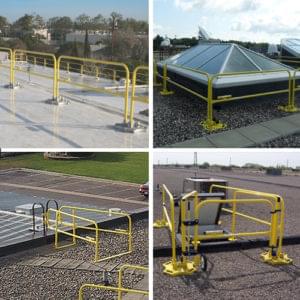Establishing an effective system for your roof is not always an easy process, especially if you lack experience or familiarity with OSHA regulations. Fortunately, you can streamline your fall protection efforts by following some simple steps. Below is your five-step guide to establishing fall protection systems for roofs.
A strong working knowledge of OSHA fall protection regulations is the cornerstone of success for a rooftop fall protection plan. Before you dive headfirst into fall protection systems, take some time to review the latest OSHA regulations. Remember that not all roofs are the same, and OSHA provides regulations that are specific to flat roofs, low-slope roofs, and steep roofs. Regulations vary depending upon the style of roof and the roof's width.
Safety managers are responsible for evaluating a roof and ensuring that employees and authorized personnel are familiar with the OSHA regulations that are specific to that type of roof. They then should follow the steps below to ensure that personnel are properly educated, trained, and protected during rooftop access.

After you become familiar with OSHA fall protection regulations, it is time to survey your rooftop and pinpoint the areas of your roof that warrant fall protection. In addition to focusing on your roof's perimeter, make sure that you devote attention to the overlooked rooftop fall hazards outlined below:
Now that you have identified the hot spots on your roof that warrant attention, it is time to seek guidance from a trusted provider of fall protection systems for roofs. Selecting a trusted industry expert to guide you in your fall protection efforts will help you save time and money as you strive to continually improve your attention to safety. Ideally, the partner you choose should possess decades of industry experience and offer an extensive selection of the latest cutting-edge protective equipment.
Investing in OSHA-compliant fall protection equipment is one of the best ways to safeguard against accidents and injury. Something as simple as a roof guardrail can help protect against falls. However, not all equipment is manufactured with the same attention to quality and OSHA standards. The most effective fall protection systems for roofs include the following elements:
"Guard against falls through skylights or other roof openings. Use a guardrail system, a personal fall arrest system (PFAS), or a protective cover that will support two times the weight that may be imposed on it at any one time."
- Occupational Safety and Health Administration Fact Sheet
There are many rooftop fall risks to note but OSHA draws special attention to the dangers posed by skylights and other roof openings. As outlined above, OSHA's Re-roofing Fact Sheet lists safety railing systems as a recommended means of safeguarding against falls. A roof guardrail provides a visual barrier for personnel while discouraging access to rooftop hazards.
The most effective safety guard rails are those that provide full protection while offering compliance with OSHA standards. Today's top guard rails provide these features while providing architectural appeal with a non-penetrating design that won’t compromise roof membrane integrity. A roof guardrail offers superb versatility, enabling safety managers to easily install and remove it for short-term projects, or install the rail for permanent use.
"For employees engaged in roofing activities on low-slope roofs with unprotected sides and edges 6 feet or more above lower levels, the following methods of fall protection are acceptable: a warning-line system and guardrail system; a warning-line system and safety net system; a warning-line system and personal fall-arrest system; or a warning-line system with a safety-monitoring system."
- National Roofing Legal Resource Center (NRLRC)
A durable, highly visible warning line system is the first line of defense against falls from a roof's perimeter. Such warning lines are particularly effective when used together with safety guard rails and OSHA-compliant safety railing systems to create a comprehensive fall protection initiative. Leading manufacturers offer durable options designed for permanent placement around roof perimeters.
"The best protection against rooftop falls is keeping people off the roof to begin with. Warning signs letting people know that access is restricted to authorized personnel only will keep most people away."
- BlueWater
Highly visible safety signage plays a key role in preventing unauthorized individuals from accessing roofs. If your facility lacks safety signage, consider posting safety signs that alert workers and visitors to the rooftop hazards you identified during Step Two. If you already use safety signage, make a point to inspect it on a monthly basis to make sure that signs are not faded, damaged, or missing. Any damaged signage should be replaced immediately.
The surest path to rooftop safety includes OSHA-compliant fall protection equipment and a robust safety training program that emphasizes the appropriate use of safety railing systems, harnesses, and other fall protection equipment. Fall protection training should be provided to all employees who are associated with a project, even those whose jobs rarely require them to access a roof. Here are some other tips to designing a comprehensive training program:
Knowing where to start when developing fall protection systems for roofs is essential to designing an effective system that complies with OSHA standards. As the world's most trusted provider of safety guard rails and other OSHA-compliant fall protection equipment, BlueWater can help you develop a comprehensive roof fall protection system that will make your facility a model of rooftop safety. We look forward to serving as your trusted resource for all of your fall protection needs!